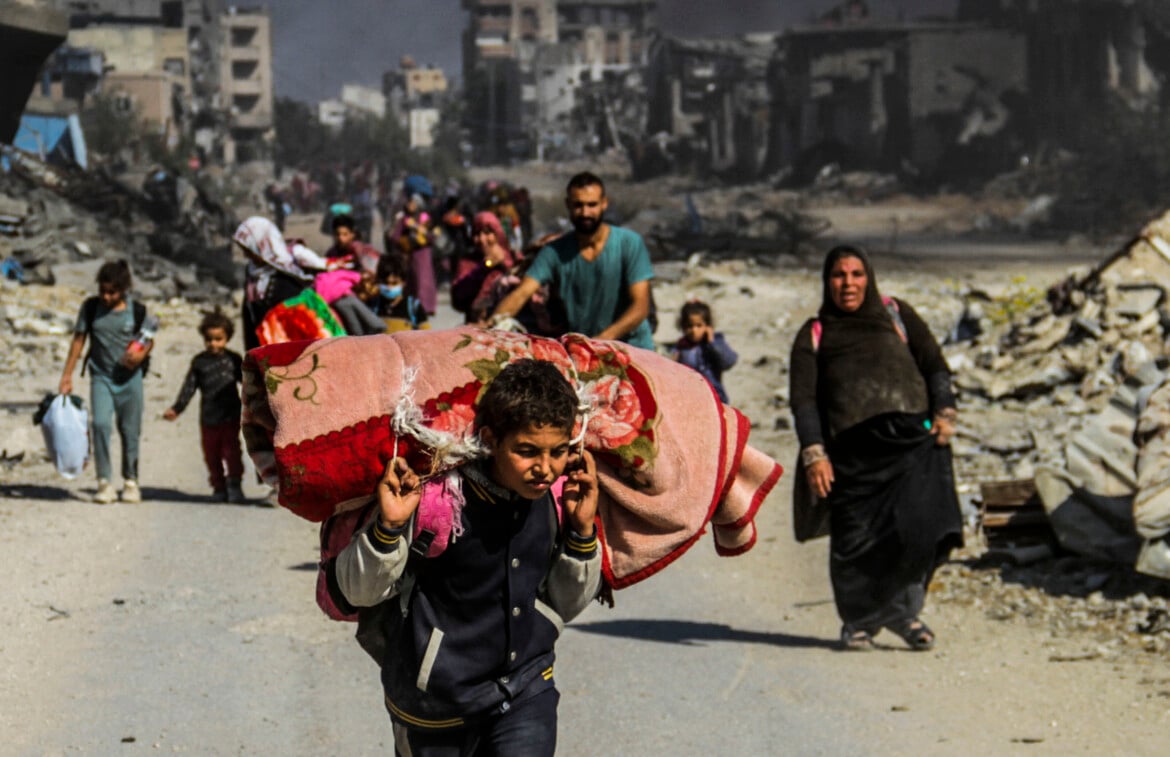Report
HRW: Gazans displaced but nowhere is safe
A new report from Human Rights Watch shows that 90% of Gazans have been displaced from their homes but without safe evacuations, in contradiction of the Geneva Convention.

“We had no idea where we were heading. That period was the hardest I’ve ever gone through. It feels like black memories I don’t want to hold onto because I don’t want to keep thinking about them. I was a burden on them [my family], an extra load alongside their belongings. I couldn't find any means of transportation. Even people without disabilities struggled with the walk, so you can imagine what it was like for someone with a disability.”
Ghazal’s testimony, a 14-year-old Palestinian girl with cerebral palsy, is one of 39 collected by Human Rights Watch in their new report, poignantly titled “Hopeless, Starving and Besieged: Israel's Forced Displacement of Palestinians in Gaza.” It included 184 evacuation orders, satellite images, videos and photographs as evidence of the widespread destruction Israel has wrought in Gaza over the past 13 months, with serious errors in the evacuation system and numerous attacks on areas designated as “safe.”
Ghazal lost her assistive devices in a bombing raid on her home on Oct. 11, 2023. They tried to go south to comply with the evacuation order, but eventually she had to beg her family to leave her behind.
Article 39 of the Geneva Convention states that civilians must be “safely evacuated,” but the HRW report proves that the manner in which Israel has displaced the Palestinian population since the beginning of the invasion has endangered lives and often killed civilians instead of protecting them. The instructions are often unclear, inaccurate or contradictory, and figuring out the right time to move and which destinations are safe – assuming there are any – is not an easy task for a Palestinian.
Dozens of orders were published online during periods of total blackout of the telecommunications network in Gaza; some were announced as the air strikes had already started or had been underway for hours, amplifying the feelings of fear, anxiety, and confusion that civilians have been living with since the start of the invasion. International humanitarian law does not specify how much time civilians should be given to leave an area, but “it would be reasonable to assume that Palestinians in Gaza should have been given orders to leave in a timely manner that were feasible to follow within that timeframe, allowing civilians enough time to evacuate safely,” the report says.
HRW's report includes an account of the events of July 1, 2024, the day the Israeli army issued an evacuation order for Rafah and Khan Younis. Among the areas affected was Al-Fukhari, where the European Hospital is located, one of the largest in the south.
The next morning, the Israeli army and the Coordination of Government Activities in the Territories (COGAT) issued a clarification in English on their X accounts, stating that the hospital was not subject to evacuation. COGAT's Arabic Facebook page updated the post about the evacuation order, but this was not shared by any of the social media accounts of the Israeli army's Arab spokesman. By the time the clarification was posted, staff and patients had already begun to flee the hospital, with great difficulty and to unknown destinations.
In Gaza, both the routes out of besieged places and the destinations are scenes of horror. But Israeli officials have never hidden their intentions to make life inside the Strip impossible: since the first days of the occupation, government ministers in Tel Aviv have said that “the territory of Gaza will decrease, that blowing up and flattening Gaza is beautiful, and that land will be handed to settlers,” the report says.
In November 2023, Avi Dichter, Israeli minister of agriculture and food security, proudly proclaimed that “We are now rolling out the Gaza Nakba.” A few days ago, the army's latest triumphant announcement about the now-deserted north of Gaza said that “there is no return to the north, and there will not be.” And while international humanitarian law stipulates that the evacuation of a population is temporary and that people must be allowed to return to their homes, the HRW report shows that for 80 percent of Palestinians, this will not be possible. Again, Israeli officials specifically admitted that in the airstrikes against the Strip, “the emphasis is on damage, not accuracy.”
The World Bank estimated that as of January 2024, more than 60 percent of residential buildings and 80 percent of commercial buildings were damaged or completely destroyed. As of August 2024, more than 93 percent of schools and all universities in Gaza had been destroyed or significantly damaged.
The United Nations Environment Program and the Al Mezan NGO’s report on the ongoing ecocide in Gaza have stressed the unprecedented impact of the war on the environment, with the pollution of soil, water and air and irreversible damage to natural ecosystems. Orchards, fields and greenhouses have been razed to the ground, as shown by satellite images collected in the HRW report. Most of the Strip's water, energy and transportation infrastructure was also destroyed.
In July, the World Health Organization (WHO) recorded more than 1,000 attacks on health facilities in the Occupied Palestinian Territories since Oct. 7, 2023, and found that there are no longer any functioning hospitals in the southernmost city of Rafah. Today, there are 1.9 million displaced Palestinians, 90 percent of the total – of those still alive, that is.
Originally published at https://ilmanifesto.it/human-rights-watch-nuovo-rapporto-senza-speranza-lo-sfollamento-dei-palestinesi-a-gaza on 2024-11-14
